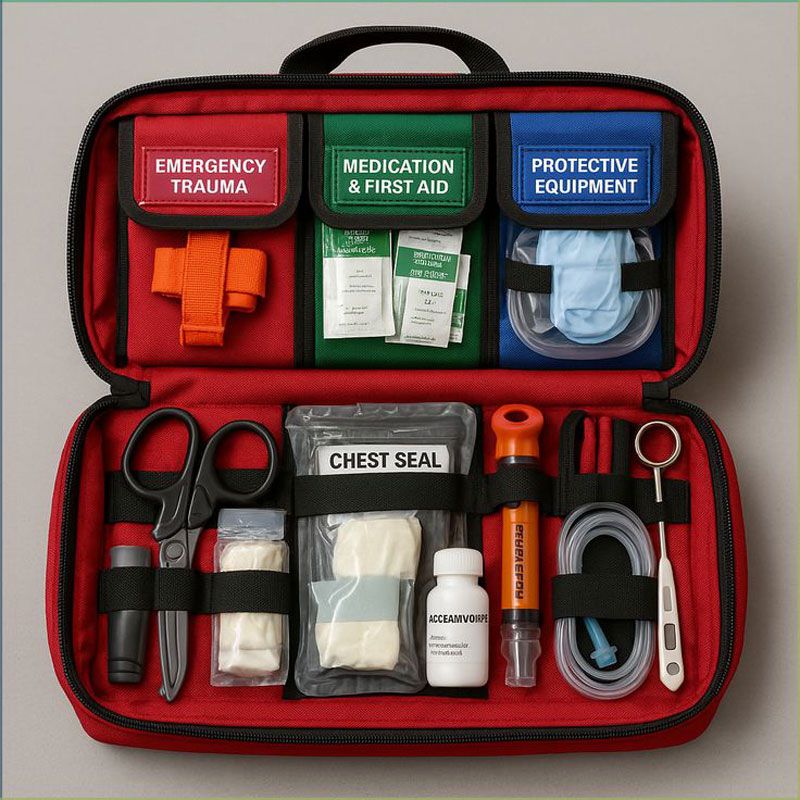My neighbor Steve came running over last week because his 8-year-old took a nosedive off her scooter. Blood all over the sidewalk, kid screaming, and Steve’s completely losing it. Goes to get his first aid kit – turns out it’s a shoebox with some Band-Aids from like 2015 and half a bottle of children’s Tylenol.
I ended up patching the kid up with my supplies. Wasn’t that serious once we cleaned her up, but Steve felt like an idiot. Made me think about how many people figure they’re prepared just because they have some random medical stuff lying around.
Truth is, most of us suck at being ready for emergencies. We tell ourselves we’ll deal with it when something happens, then panic when someone actually gets hurt.
Why This Matters More Than You Think
Time’s Not on Your Side
When my 12-year-old sliced his finger on a can lid, I had about 30 seconds before he was going to pass out from the blood. No time to hunt around for supplies or figure out what to do. Either you’re ready or you’re not.
My sister-in-law learned this when her toddler pulled a pot of boiling water off the stove. Second-degree burns on his arm. She had burn gel ready and knew what to do – probably saved him from needing skin grafts.
Small Cuts, Big Problems
You know what’s expensive? Getting an infection from a cut that should’ve healed fine. My coworker got a scrape on his shin, didn’t clean it right, and ended up spending $300 at urgent care for antibiotics.
Having the right first aid supplies means you can clean wounds properly instead of just hoping for the best.
Nobody Likes Chaos
Before I got my act together with first aid stuff, every injury turned into a circus. Kids crying, me running around looking for anything useful, my wife getting frustrated because we never had what we needed.
Now when someone gets hurt, we handle it without drama. Kids barely cry anymore because they know we can fix whatever’s wrong.
What Actually Goes in the Box
Bandages That Don’t Fall Off
Get real bandages in different sizes. Not those cheap ones that peel off if you look at them wrong. Kids always hurt themselves in ways that need bigger coverage than those little strips.
Gauze pads for anything serious. Medical tape that sticks but doesn’t rip your skin off. Antiseptic wipes or liquid – whatever you prefer.
Cotton balls are useful for cleaning around cuts and applying ointment. Don’t overthink it, just get stuff that works.
Pills That Help
Regular Tylenol and Advil. Kids’ versions if you have little ones. Burn cream for kitchen disasters (trust me, you’ll need it).
Benadryl or whatever allergy medicine your family uses. Bee stings happen, kids eat weird things, people touch stuff they shouldn’t.
Check expiration dates once in a while. Old medicine is useless and sometimes dangerous.
Tools That Work
Decent scissors for cutting tape and gauze. Good tweezers for splinters and getting crap out of wounds. Safety pins for holding stuff together.
Don’t use your wife’s good scissors or makeup tweezers. Get proper medical tools that do the job right.
Serious First Aid Equipments for Bad Days
Fever Checker
Digital thermometer so you know if someone’s actually sick or just being dramatic. Kids especially – their fevers can spike fast and you need to know if it’s serious.
Breathing Stuff
CPR mask in case someone stops breathing. Never used mine, hope I never have to, but if someone’s dying and you know what you’re doing, you’ll want it.
Hot and Cold
Instant cold packs for sprains and bumps. Just squeeze and they get cold – no ice needed. Hot packs for muscle pain.
Both are cheap and help with different types of injuries.
Protection
Rubber gloves because other people’s blood is nasty. Get the nitrile ones – latex makes some people break out.
Good first aid equipments keep you safe while you’re helping someone else.
Different Kits for Different Situations
Home Base
Main kit should have everything. Keep it where adults can get to it but medicines are away from kids.
Mine’s in the kitchen pantry because that’s where most accidents happen anyway.
Car Kit
Focus on serious stuff – bad bleeding, broken bones, car accident injuries. Keep it compact but effective.
Vacation Kit
Smaller version for trips. Handle common travel problems – cuts, stomach bugs, sunburn, allergic reactions to new foods.
Work Stuff
Depends what you do. Office work means basic cuts and burns. Construction or warehouse work needs trauma supplies.
Family Needs
Kids need special supplies – smaller bandages, kid-safe medicines, stuff that doesn’t scare them.
If grandma lives with you or someone has diabetes or bad allergies, include supplies for their specific problems.
Seasonal Changes
Summer means bug spray, sunscreen, extra allergy stuff. Winter means cold medicine and supplies for heating accidents.
Just swap out a few things based on what problems are more likely.
Keeping Everything Ready
Where to Put It
Somewhere cool and dry where you can find it fast. Not the bathroom – too hot and steamy. Kitchen or bedroom closet works better.
Clear container so you can see what you have. When someone’s bleeding, you don’t want to dig through boxes.
Checking Your Stuff
Go through your first aid supplies every few months. Throw out expired medicine, replace anything you used.
I check mine when I do other house maintenance stuff. Easy to remember that way.
Replace What You Use
Don’t wait to restock after using supplies. Next emergency always happens right after you used up what you needed.
Just Get It Done
Building a first aid kit isn’t rocket science. You don’t need to become a doctor or spend a fortune on fancy equipment. Just get basic first aid supplies and first aid equipments that handle normal injuries.
Most accidents at home are pretty routine. Cuts, burns, scrapes, bumps. Having the right stuff means you can deal with these things without losing your mind.
Stop putting this off. Don’t wait until your kid crashes their bike or someone burns themselves cooking to find out your first aid kit is worthless. Take a couple hours this weekend to put together something that actually works. Your family will thank you the first time someone gets hurt and you’re ready instead of panicking.

Reblog It collaborates closely with clients to develop tailored guest posting strategies that align with their unique goals and target audiences. Their commitment to delivering high-quality, niche-specific content ensures that each guest post not only meets but exceeds the expectations of both clients and the hosting platforms. Connect with us on social media for the latest updates on guest posting trends, outreach strategies, and digital marketing tips. For any types of guest posting services, contact us on reblogit.webmail[at]gmail.com.
